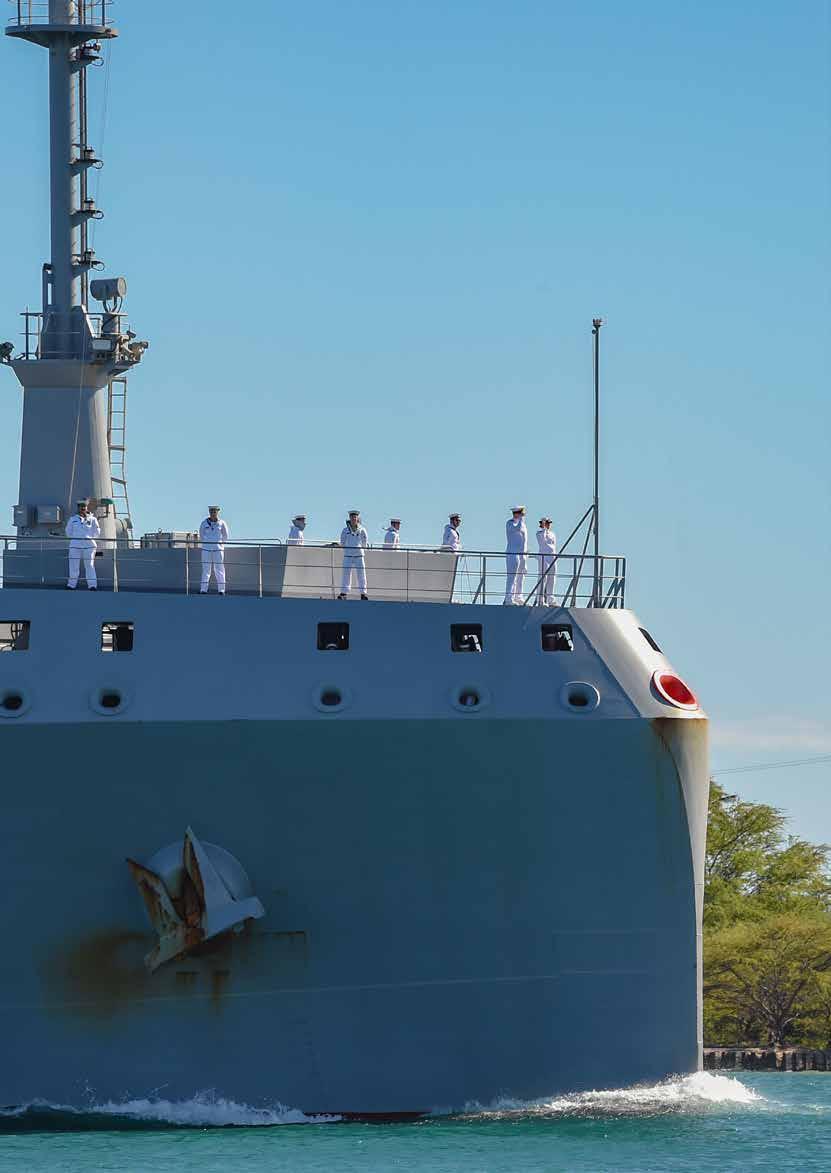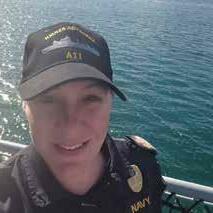
6 minute read
Enroute for RIMPAC
HMNZS AOTEAROA: 22 WEEKS DEPLOYED
HMNZS AOTEAROA is taking part in the world’s largest international maritime exercise for the first time, as part of a five-and-a-half month deployment to the Asia Pacific region. After COVID-19 restrictions kept HMNZS MANAWANUI at sea only for the 2020 Rim of the Pacific (RIMPAC) multinational exercise, RIMPAC 22 is back to a full-scale, combined live field training exercise at sea, in the air, and on land.
Twenty-six nations are taking part in RIMPAC 22, hosted by Commander US Pacific Fleet. The exercise will include 38 surface vessels, four submarines, more than 170 aircraft and approximately 25,000 personnel. The exercise is being conducted primarily in the vicinity of Hawaii and Southern California from 29 June to 4 August. The theme of RIMPAC 22 is Capable, Adaptive, Partners, and participating nations will exercise a range of capabilities ranging from disaster relief and maritime security operations to complex warfighting. Maritime Component Commander Commodore Garin Golding said the NZDF’s primary purpose was to conduct military operations in support of New Zealand’s national security interests. Participating in a multinational training activity of the scale of RIMPAC 22 provided the NZDF with an unparalleled opportunity to hone skills the NZDF could be called on to use, and would enhance interoperability with military partners, he said. “This will be a real test of warfighting capabilities and exciting to be part of for all those involved. Each day will challenge our people as they exercise real-life scenarios in a multi-national environment.”
In addition to HMNZS AOTEAROA, HMNZS MATATAUA’s dive and hydrography teams will be based in San Diego where they will undertake activities including mine counter measures. In addition, NZ Army has sent a Joint Fires Team including Joint Terminal Attack Controllers, and Royal New Zealand Air Force, Army and Navy personnel are filling roles in both the Combined Air Operations and Warfighting Centres. For the first time, New Zealand will fill the Carrier Strike Group Sea Combat Commander role, taken up by Captain Stephen Lenik. His staff will be embarked in USS MOBILE BAY for the duration.
CAPT Lenik said that as the Sea Combat Commander, he was looking forward to working with his team to test their skills in a challenging, multi-domain environment, integrating the combat capabilities of numerous warships, carrier and land-based aircraft to achieve sea control in support of the overall exercise mission, “and strengthen relationships with our regional partners while doing so. “The unique benefit of RIMPAC is that it provides access to first-rate training opportunities alongside partner nations. Exercising in this way makes us collectively more agile and able to respond quickly to security incidents in our region,” he said. AOTEAROA will be one of only a few replenishment tankers involved.
“Operating in company, in a large task group of ships, will test everyone on board – from our Communications Warfare Specialists who will work around the clock providing real time tactical communications, to the Combat Systems Specialists with their ability to track, classify and build a situational awareness picture, our marine and electronics technicians who keep the ship running from the temperate waters of New Zealand to the tropical waters of Hawaii, and more.” He said it was the first deployment for many on board the ship, and after two years of COVID restrictions, they were looking forward to travelling. “The travel is one of the reasons so many young people join the Navy and they’re looking forward to experiencing something new.” The ship’s involvement in RIMPAC 22 will be part of an almost six-month deployment to the Indo-Pacific region. The ship will have a number of international engagements including attendance at the Japanese Maritime Self-Defence Force International Fleet Review in November, before returning to New Zealand in time for Christmas.
First Command Warrant Officer For Aotearoa

The inaugural appointment of a Command Warrant Officer (CWO) for HMNZS AOTEAROA reflects the ship’s global abilities and mission skillset for the Royal New Zealand Navy.
It’s a good match for the skillsets of Warrant Officer Hydrographic Survey Technician Karen Foster, who has served for 22 years in roles that have included deployments in HMNZ Ships RESOLUTION, ENDEAVOUR, CANTERBURY and OTAGO, plus postings to PHILOMEL, the Hydrographic Office, Detached Hydrographic Survey Unit, the Maritime Survey Team, the RNZN Hydrographic School, the Fleet Personnel and Training Organisation and Naval Staff within Defence House in Wellington. She has served operationally in Afghanistan and Bahrain, most recently last year as New Zealand’s Battle Watch Captain for Combined Task Force 150, when New Zealand led drug interdiction operations in the Indian Ocean.
She comes to AOTEAROA from a posting as Deputy Director Naval Strategy (Implementation), and says she is excited about the new role. She’s on board for the nearly sixmonth Operation Crucible through South East Asia, including Exercise RIMPAC in Hawaii.
“The ship’s command team have done a lot of work to create this new role,” she says. “The Navy has been talking about its people as its assets and this new appointment is walking the talk. The Command Warrant Officer is focused on the people, that’s the heart of it. I try to make people’s lives better by listening to them, seeing what they need, and making sure the messages from them are getting through.” Her last significant sea posting was as a Chief Petty Officer in RESOLUTION in 2012, when she saw her decommission. “For Warrant Officers who aren’t technical trades, it can be harder to get back on a ship. Marine Technicians, Electronic Technicians, no problem, but it’s more challenging for Support and Operations trades.” She says a past posting in career management required skills not unlike that of a CWO. “It’s about being honest with people, matching what the organisation needs with what a person needs, and having the conversation and working the adjustments needed to make things fit.” She’s already been told she brings a whole new level of energy to AOTEAROA, which possibly also helps with getting from deck to deck and finding her way around. “This ship is big and there are a lot of stairs!” The high level of accommodation is something she’s never encountered before, and she wonders how the Navy’s junior rates will cope, going from a ship with generous accommodation and a junior rates’ recreation space, to the spartan confines of an Anzac-class frigate. “The junior members are pretty excited about this deployment,” she says. “I’ve done a lot of things in my career, and I did a similar kind of deployment in ENDEAVOUR when I was a Leading Hand. But this is something new. I’m looking forward to the culture engagement with other Navies. You learn a lot from other people and you find we do a lot of things the same way. It’s great seeing junior sailors getting the opportunity to experience it, and I feel very privileged to be in this position. I want those coming after me to see there’s a position like this.” AOTEAROA’s Executive Officer, Lieutenant Commander Richard McGinily, says AOTEAROA’s predecessor ENDEAVOUR didn’t have a CWO but there was simply no comparison between the two ships. “AOTEAROA conducts significant operations more in line with that of a warship than an Auxiliary ship, and we routinely deploy with over 90 personnel. We’re very pleased and excited to have a CWO.” Warrant Officer Hydrographic Survey Technician
Karen Foster







